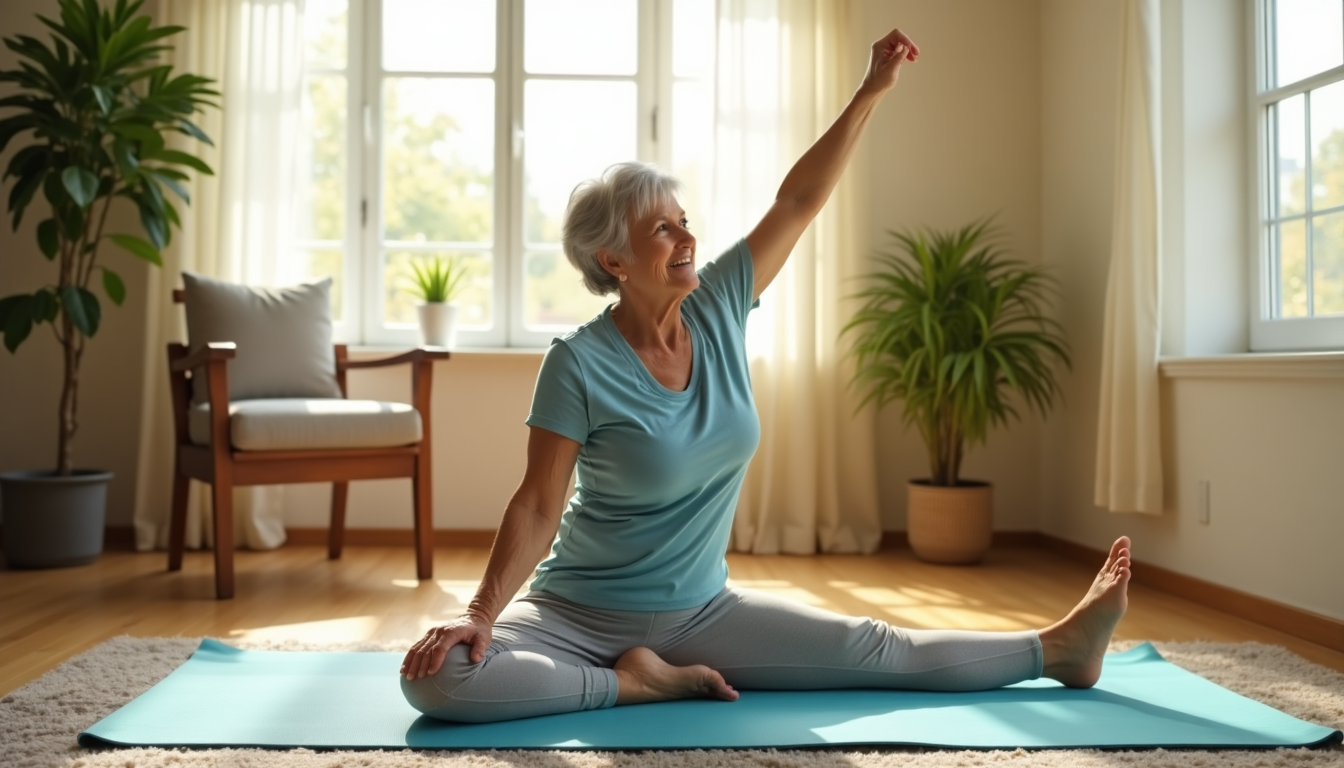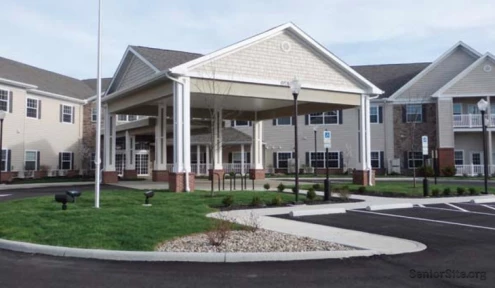Did you know that 8 out of 10 people will experience back pain during their lifetime? In fact, it’s the second most common reason people visit their doctor’s office.
If you’re a senior dealing with lower back pain, you’re certainly not alone. However, there’s good news – gentle exercises and stretches can help ease your discomfort while building strength and flexibility. Fortunately, you don’t need complex equipment or intense workouts to find relief.
We’ve compiled a collection of doctor-approved exercises for lower back pain for seniors that you can safely practice at home. These simple yet effective movements focus on stretching tight muscles, strengthening your core, and improving overall mobility.
Ready to start feeling better? Let’s explore these gentle exercises that can help you manage and prevent lower back pain effectively.
Start with Gentle Warm-Ups
Before diving into any exercise regimen, proper preparation is essential – especially for older adults. Warming up becomes increasingly important as we age due to natural changes in our bodies. Let me show you why this step is non-negotiable and share some effective moves to get you started safely.
Why warming up matters for seniors
The aging process brings significant changes to our muscles, joints, and connective tissues. As we get older, our muscles lose some elasticity, joints may develop stiffness, and our overall flexibility decreases. Consequently, jumping straight into exercises without preparation increases the risk of injury.
Back pain is the second most common reason people visit their doctors, according to the American Chiropractic Association. Fortunately, most cases of back pain are mechanical rather than caused by serious conditions like infections or fractures. This means proper movement preparation can make a substantial difference.
For seniors specifically, warming up serves multiple critical purposes:
First, it gradually increases heart rate and circulation, ensuring more oxygen reaches your muscles. This is particularly crucial as sudden vigorous activity can put extra stress on your heart.
Second, warm-up exercises raise your body temperature, which makes muscle tissue more pliable and improves electrical signals along nerve fibers. This increases muscular contraction speed and force – essentially “waking up” your body systems.
Third, warming up improves joint health by accumulating synovial fluid between joints, which protects your articular cartilage. This is especially beneficial for seniors with arthritis or joint stiffness.
An effective warm-up should last between 6-15 minutes. Those with arthritis or heart conditions may need slightly longer. You should aim to break a light sweat, indicating your core temperature has risen appropriately.
Simple warm-up moves to get started
I recommend starting with these gentle but effective warm-up exercises before attempting any back-specific movements:
1. Seated trunk rotation
- Sit forward on a sturdy chair with feet flat on floor, shoulder-width apart
- Cross arms over your chest
- Keep hips facing forward
- Gently rotate to the right as far as comfortable, then return to center
- Rotate to the left, then return to center
- Repeat 10 times on each side
2. Gentle arm circles
- Stand tall with feet hip-width apart
- Extend arms out to sides at shoulder level
- Move arms in small forward circles for 30 seconds
- Reverse direction for another 30 seconds
- Maintain slight bend in elbows to avoid strain
3. Walking in place
- Begin with a slow pace, gradually increasing intensity
- Lift knees only as high as comfortable
- Allow arms to swing naturally at sides
- Continue for 2-3 minutes to increase circulation
Above all, remember these important safety considerations during your warm-up:
Never stretch to the point of pain – warming up should feel good, not painful. Breathe regularly throughout each movement rather than holding your breath. Start slowly and gradually build intensity, especially if you’re new to these exercises.
Additionally, always consult your doctor or physical therapist before beginning any new exercise routine, particularly if you currently experience back pain.
By taking just a few minutes to properly prepare your body, you’ll significantly improve your exercise results and reduce injury risk. Forthwith, we’ll explore specific stretching exercises that target lower back pain.
Stretching Exercises for Lower Back Pain Relief
Now that your body is warmed up, let’s focus on specific stretches that target lower back pain relief. These gentle exercises are designed to release tension, improve flexibility, and provide relief to your aching back. I’ve selected three doctor-approved stretches that are particularly effective for seniors.
Knee-to-chest stretch
The knee-to-chest stretch is one of the most beneficial exercises for lower back pain relief. This gentle movement helps lengthen your lower back muscles and alleviate tension.
To perform this stretch correctly:
- Lie on your back with your knees bent and feet flat on the floor
- Using both hands, grasp your lower right leg and interlace your fingers just under the knee
- Gently pull your right knee toward your chest until you feel a mild stretch in your lower back
- Keep your left foot flat on the floor and relax your hips and lower back completely
- Hold for 30-60 seconds while breathing normally
- Release your right knee and return to starting position
- Repeat with your left leg
- Perform 3 repetitions for each leg
This stretch works by loosening tight muscles across your lower back and buttocks. Primarily, it stretches the erector spinae, latissimus dorsi, and gluteus muscles. For seniors with arthritis or disk issues, this stretch is generally safe, though starting with just one knee may be more comfortable.
Seated cat-cow stretch
For seniors who have difficulty getting up from the floor, the seated cat-cow provides the same benefits without having to kneel. This exercise stretches both the lumbar (lower) and thoracic (middle) parts of your spine.
To perform the seated cat-cow:
- Sit forward on a chair with feet firmly planted on the floor and knees at a 90-degree angle
- Place hands on your knees with fingers pointing inward
- As you inhale, gently arch your back, lift your chest, and tilt your head slightly upward (Cow Pose)
- As you exhale, round your back, pull your belly button toward your spine, and tuck your chin toward your chest (Cat Pose)
- Move slowly between these positions, following your breath
- Repeat 3-5 times, twice daily if possible
This stretch benefits multiple muscle groups simultaneously, including your lower back, core, chest, hips, and neck. Furthermore, it helps relieve lower back pain and sciatica while aligning your spine. Many seniors find they can practice this stretch multiple times throughout the day to release tension.
Supine twist for spinal mobility
The supine twist is exceptionally effective for improving spinal flexibility and can help prevent future lower back pain. Additionally, this gentle twist stimulates digestion and circulation while toning your abdominal muscles.
To perform this properly:
- Lie on your back with knees bent and feet flat on the floor
- Extend your arms out to the sides with palms facing down
- Keeping your knees together, gently roll both bent knees to the right side
- Hold for 15-20 seconds while breathing deeply
- Return to center and repeat on the left side
- Perform 5-10 repetitions on each side
The supine twist relieves tension along the quadratus lumborum (QL) muscle, a common source of lower back pain. Moreover, this stretch works multiple back muscles including the erector spinae and rhomboids.
For enhanced comfort, you can place a pillow or bolster between your knees. This modification improves spinal mobility while making the stretch more accessible, particularly for seniors with tight hips or injuries. The support allows you to stay longer in the position, promoting deeper relaxation.
Ultimately, incorporating these three stretches into your daily routine can significantly improve your back mobility and reduce pain. Remember to move gently and never push through pain—these exercises should feel like a pleasant release, not a strain.
Strengthening Back Muscles Safely
After loosening tight muscles with stretching, strengthening weak muscles becomes the next crucial step in managing lower back pain. Weak abdominal muscles often contribute to back pain, and strengthening these muscles provides better support for your spine and reduces injury risk. Let’s explore three effective exercises that build strength while remaining gentle enough for seniors.
Bridge pose to activate glutes
The bridge pose effectively strengthens your back, buttocks, and hamstring muscles. This movement provides vital support to your spine while relieving tension and fatigue.
To perform the bridge correctly:
- Lie on your back with knees bent and feet flat on the floor, hip-width apart
- Place arms alongside your torso with palms facing down
- Tighten the muscles in your belly and buttocks
- Press through your heels to lift your hips, forming a straight line from shoulders to knees
- Hold long enough to take three deep breaths
- Return to starting position and repeat
Begin with five repetitions daily, gradually working up to 30. For best results, remember to tighten your gluteus and abdominal muscles while in position to maintain correct alignment.
Bird dog for core and balance
Bird dog is a powerful exercise targeting your “corset muscle” – the transverse abdominis. These deep core muscles wrap around your sides and spine, helping you stay steady and prevent back pain.
To perform the bird dog:
- Start on hands and knees with hands under shoulders and knees under hips
- Pull your belly button toward your spine to keep your back flat
- Simultaneously extend your right arm forward and left leg backward
- Maintain balance through your core and glutes
- Hold for 3-5 seconds while keeping hips parallel to floor
- Return to starting position and repeat on opposite side
Aim for 10 repetitions on each side, 3-5 times weekly. This exercise strengthens the erector spinae, rectus abdominis, and glutes – muscles that provide movement control and stability throughout your body.
Pelvic tilts to support the spine
Pelvic tilts activate the transverse abdominis, your deepest abdominal muscle that wraps around the spine providing stability. This gentle exercise stretches and strengthens your abdominal muscles simultaneously.
To perform pelvic tilts:
- Lie on your back with knees bent and feet flat on the floor
- Allow your back to maintain its natural curve
- Inhale deeply
- As you exhale, engage your abdominal muscles to tilt your tailbone upward
- Feel your lower back gently press into the floor
- Hold briefly, then return to starting position
- Repeat 5-10 times
This exercise strengthens your back, improves core stability, and can be performed daily to support proper spinal alignment. Should floor exercises prove difficult, standing or seated variations offer the same benefits.
Ultimately, these strengthening exercises, when practiced regularly, provide crucial support for your lower back, helping to prevent future pain episodes and improve your overall mobility.
Posture and Breathing Techniques
The way you hold yourself throughout the day plays a crucial role in managing lower back pain. Beyond exercises, your posture and breathing patterns directly impact your comfort level and spinal health. These two often-overlooked aspects can significantly affect how your back feels day to day.
How posture affects back pain
Poor posture is one of the top causes of lower back pain, placing uneven stress on the spine and surrounding muscles. Studies show that prolonged poor posture is a potential risk factor for lumbar spine injuries and can lead to chronic nonspecific low back pain. When you slouch or hunch forward, you increase mechanical stress in your lower back, which often results in discomfort and pain.
Common problematic postures include:
- Lumbar lordosis – excessive inward curve of the lower back
- Sway-back – hips pushed forward with upper back leaning backward
- Round back – shoulders hunched forward
- Flat back – insufficient natural curve in the spine
The link between posture and pain creates a challenging cycle. When you experience back pain, you might unconsciously adopt positions that temporarily feel better but actually worsen your alignment long-term. Unfortunately, this creates a pattern where poor posture leads to pain, which leads to more posture problems.
Diaphragmatic breathing to reduce tension
Interestingly, people with chronic low back pain breathe differently than those without pain. Many individuals with back pain rely on accessory breathing muscles rather than properly using the diaphragm. Since these accessory muscles connect to your neck and lower back, they create more stress, strain, and compression through your spine when overused.
To practice diaphragmatic breathing:
- Sit comfortably or lie on your back
- Place your left hand on your stomach at your navel
- Rest your right hand on your chest
- Breathe in slowly through your nose, feeling your stomach expand
- Keep your chest relatively still (minimal hand movement)
- Exhale slowly through pursed lips
- Practice for 2-3 minutes several times daily
Studies indicate that just one two-minute session of diaphragmatic breathing reduces tension in muscles along the neck and back. This technique helps lower blood pressure, decrease heart rate, and improve relaxation. Comparatively, proper diaphragmatic breathing activates your parasympathetic nervous system, promoting relaxation and reducing stress – key factors in pain management.
With this mind-body connection, combining proper posture awareness with regular diaphragmatic breathing creates a powerful approach to managing lower back discomfort.
Cool Down and Recovery Tips
Completing your exercise routine properly is just as important as how you begin it. Taking time to cool down helps your body transition safely from activity to rest while promoting faster recovery.
Child’s pose for relaxation
Child’s pose provides deep relaxation by stretching the muscles of the lower back and inner thighs. This restorative position brings the spine into the opposite direction that typically causes irritation, allowing nerves more space.
To perform child’s pose correctly:
- Start in a kneeling position with tops of feet against the floor
- Touch your big toes together while keeping knees hip-width apart
- Slowly lower your hips back toward your feet
- As you exhale, bend forward bringing your forehead toward the floor
- Extend your arms in front with palms down for a deeper stretch
- Take long, slow breaths and hold for as long as comfortable
If this position feels difficult, place a pillow between your thighs and lower legs for support. This modification may help relax tension around the sacroiliac area.
When to use heat or ice
For acute back pain (less than 4 weeks duration) or after direct injury, use cold therapy first. Ice helps constrict blood vessels, reduce swelling, decrease inflammation, and create a numbing effect.
Once inflammation subsides, switch to heat therapy. Heat improves soft tissue flexibility, muscle movement, and overall back function by stimulating blood circulation and bringing healing nutrients to injured tissues.
For chronic back pain (more than 4 weeks), apply constant warmth using heating pads or warm towels. Apply either treatment for 15-20 minutes with a 2-hour break between sessions to prevent skin damage.
Signs you should stop and consult a doctor
Exercise should not worsen your existing back pain overall. While some temporary discomfort is normal, your pain should be no worse the morning after exercising.
Stop immediately and seek medical attention if you experience:
- Leg weakness, incontinence, and numbness together (could indicate cauda equina syndrome requiring emergency care)
- Chest pain or pressure
- Pain that feels like “burning or stabbing” rather than muscle soreness
- Back pain that doesn’t improve within 6 weeks of following proper exercise advice
Remember, gradually returning to normal activities produces the best long-term results after any back problem.
Conclusion
Managing lower back pain requires patience, consistency, and the right approach. These gentle exercises, combined with proper breathing techniques and posture awareness, offer effective ways to reduce discomfort and improve mobility.
Remember to start slowly with warm-ups, progress through stretches and strengthening moves at your own pace, and always end with proper cool-down routines. Most importantly, listen to your body – while mild discomfort during exercise is normal, sharp or increasing pain signals the need to stop and consult your healthcare provider.
Regular practice of these doctor-approved exercises will help build strength, enhance flexibility, and support better spinal health. Though results may take time, staying committed to this gentle exercise routine can lead to lasting relief from lower back pain and improved quality of life.
FAQs
Q1. How often should seniors perform these back exercises? It’s recommended to start with 2-3 times per week, gradually increasing to daily practice as you become more comfortable. Always listen to your body and consult your doctor before starting any new exercise routine.
Q2. Are these exercises safe for seniors with arthritis? Most of these exercises are gentle and can be modified for those with arthritis. However, it’s important to start slowly and stop if you experience pain. Consult your healthcare provider for personalized advice.
Q3. Can these exercises help with sciatica pain? Yes, many of these exercises, particularly the stretches like the knee-to-chest and seated cat-cow, can help alleviate sciatica pain by improving flexibility and reducing pressure on the sciatic nerve.
Q4. How long should I hold each stretch? Generally, hold each stretch for 15-30 seconds, or as long as comfortable without pain. For strengthening exercises, aim for 5-10 repetitions to start, gradually increasing as you build strength.
Q5. What if I can’t get down on the floor for some of these exercises? Many of these exercises can be modified to perform while seated or standing. For example, the cat-cow stretch can be done in a chair, and the bridge pose can be adapted to a standing position against a wall.












